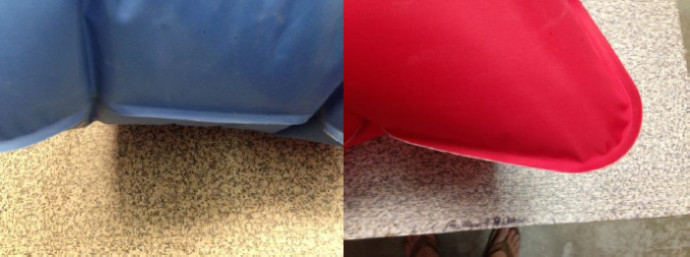Many sailors don’t understand the problems inherent to an Optimist airbag and how to care for them. As a result, every summer, we go through a ton of airbags here at the shop. Why do we send out so many?
Following are some helpful tips for keeping your airbags in shape and in your boat!
What makes an Optimist airbag pop?
Inflation is an issue your sailor should be constantly aware of.
It’s their responsibility to ensure that the correct amount of air is in their airbag.

First, a properly inflated airbag will keep the boat from taking on too much water in the event of a capsize, and will ensure less bailing time and more sailing time.
An Optimist airbag can be properly inflated while on shore, and after that will need to be blown up more once on the water.
The colder water temperature on the hull decreases air pressure in the bag. The real problem occurs when the boat hits the shore, and sits in the sun.
Optimist airbag tips — cold, hot effects
Without the cold water to decrease air pressure, the bag is now overfilled and pops. So, every time you come off the water, let a little air out of your bag. After all, you can always blow a little more hot air into it!
A good airbag is made with double seals around the edge, to prevent failure from over inflation.
Abrasion is the second recurring reason for Optimist airbag failure. Common causes of abrasion are non-skid and underneath your deck.
The non-skid in your boat can be very aggressive.
Most non-skid is made from sand particulates in paint, which is what gives you grip. That sand can be very
sharp!
Keep your bags properly inflated to make sure they stay in your airbag straps, and away from rubbing on your non-skid.

Abrasion underneath your deck is more common than that from non-skid. Your airbag sits against the underside of your deck, and moves slightly all the time. As a result of that movement, wearing and fraying of the bag can end in a bag failure.
Optimist airbag tips — Denier count is important
You can buy airbags that are more resistant to abrasion by choosing an airbag made from a denier count of 200 or more, and avoiding PVC or PVC coated nylon airbags.
Denier is a unit of measurement of thread count of specific materials. 200 denier is a ballistic material, and is very strong. PVC bags are much weaker, and do not wear well. You can tell the difference between nylon and a good denier bag by feel.
For instance, if the bag feels smooth and rubbery, it is PVC or made from a nylon with a low denier count. If you can feel and see threads on the bag, it is a good denier.
You can avoid under deck wear by removing the airbags while trailering or car topping. But all airbags will wear at some point. Be sure to check your bags before going out on the water.
I hope this helps you understand that all airbags are not the same! In other words, for longer life for your Optimist airbag, purchase bags that have a good denier count. Also, check your airbags often for inflation and any abrasion issues.
Above all, our staff continues to wish you Fair Sailing!
Every sailor wants to have an edge when it comes time to compete, and now you know how to get it.